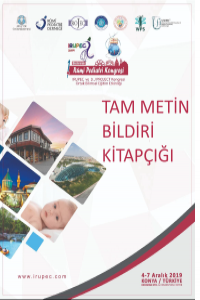Abstract
Abstract
The normal neonate’s immune system is anatomically intact, antigenically naive, and shows somewhat decreased role of a number of immunological pathways. Aside from anatomic characteristics (eg, thin skin and mucosal barriers) of newborn, weakened proinflammatory and T helper cell type 1 (Th1) cytokine release and lessened cell-mediated immunity predispose the neonate more susceptible to all types of infections. However, most of the newborn stand this period without sickness due to intact innate immunity with other adaptive defense mechanisms, and maternally transferred immunoglobulin G (IgG).
Besides unique immunity of the premature baby and normal newborn; risk factors, clinical features and laboratory evaluation of primary immunodeficiency diseases (PIDs) are told in this presentation. Moreover, most important PIDs of the newborn including antibody deficiencies, cellular/combined immunodeficiencies, phagocytic diseases, complemento-pathies and innate immune system disorders are briefly mentioned here as well.
Keywords
References
- References 1. Subbarayan A, Colarusso G, Hughes SM, et al. Clinical features that identify children with primary immunodeficiency diseases. Pediatrics 2011; 127:810. 2. Del Vecchio A, Christensen RD. Neonatal neutropenia: what diagnostic evaluation is needed and when is treatment recommended? Early Hum Dev 2012; 88 Suppl 2:S19. 3. Stiehm ER, Ochs HD, Winkelstein JA. Immunodeficiency disorders: General considerations. In: Immunologic disorders in Infants and Children, 5th ed, Stiehm ER, Ochs HD, Winkelstein JA (Eds), Elsevier, Philadelphia 2005. p.311. 4. Kwan A, Church JA, Cowan MJ, et al. Newborn screening for severe combined immunodeficiency and T-cell lymphopenia in California: results of the first 2 years. J Allergy Clin Immunol 2013; 132:140. 5. Bousfiha AA, Jeddane L, Ailal F, et al. A phenotypic approach for IUIS PID classification and diagnosis: guidelines for clinicians at the bedside. J Clin Immunol 2013; 33:1078. 6. Sharma AA, Jen R, Butler A, Lavoie PM. The developing human preterm neonatal immune system: a case for more research in this area. Clin Immunol 2012; 145:61. 7. Ballow M, Cates KL, Rowe JC, et al. Development of the immune system in very low birth weight (less than 1500 g) premature infants: concentrations of plasma immunoglobulins and patterns of infections. Pediatr Res 1986; 20:899. 8. Kobayashi RH, Hyman CJ, Stiehm ER. Immunologic maturation in an infant born to a mother with agammaglobulinemia. Am J Dis Child 1980; 134:942. 9. Picard C, von Bernuth H, Ghandil P, et al. Clinical features and outcome of patients with IRAK-4 and MyD88 deficiency. Medicine (Baltimore) 2010; 89:403. 10. Mahmoudi M, Mollnes TE, Kuijpers T, et al. Complement deficiencies. In: Primary Immunodeficiency Diseases - Definition, Diagnosis, and Management, Rezaei N, Aghamohammadi A, Notarangelo L (Eds), Springer, Berlin 2008. p.235.
Abstract
References
- References 1. Subbarayan A, Colarusso G, Hughes SM, et al. Clinical features that identify children with primary immunodeficiency diseases. Pediatrics 2011; 127:810. 2. Del Vecchio A, Christensen RD. Neonatal neutropenia: what diagnostic evaluation is needed and when is treatment recommended? Early Hum Dev 2012; 88 Suppl 2:S19. 3. Stiehm ER, Ochs HD, Winkelstein JA. Immunodeficiency disorders: General considerations. In: Immunologic disorders in Infants and Children, 5th ed, Stiehm ER, Ochs HD, Winkelstein JA (Eds), Elsevier, Philadelphia 2005. p.311. 4. Kwan A, Church JA, Cowan MJ, et al. Newborn screening for severe combined immunodeficiency and T-cell lymphopenia in California: results of the first 2 years. J Allergy Clin Immunol 2013; 132:140. 5. Bousfiha AA, Jeddane L, Ailal F, et al. A phenotypic approach for IUIS PID classification and diagnosis: guidelines for clinicians at the bedside. J Clin Immunol 2013; 33:1078. 6. Sharma AA, Jen R, Butler A, Lavoie PM. The developing human preterm neonatal immune system: a case for more research in this area. Clin Immunol 2012; 145:61. 7. Ballow M, Cates KL, Rowe JC, et al. Development of the immune system in very low birth weight (less than 1500 g) premature infants: concentrations of plasma immunoglobulins and patterns of infections. Pediatr Res 1986; 20:899. 8. Kobayashi RH, Hyman CJ, Stiehm ER. Immunologic maturation in an infant born to a mother with agammaglobulinemia. Am J Dis Child 1980; 134:942. 9. Picard C, von Bernuth H, Ghandil P, et al. Clinical features and outcome of patients with IRAK-4 and MyD88 deficiency. Medicine (Baltimore) 2010; 89:403. 10. Mahmoudi M, Mollnes TE, Kuijpers T, et al. Complement deficiencies. In: Primary Immunodeficiency Diseases - Definition, Diagnosis, and Management, Rezaei N, Aghamohammadi A, Notarangelo L (Eds), Springer, Berlin 2008. p.235.
Details
| Primary Language | English |
|---|---|
| Subjects | Health Care Administration |
| Journal Section | Congress Proceedings |
| Authors | |
| Publication Date | December 10, 2019 |
| Acceptance Date | January 16, 2020 |
| Published in Issue | Year 2019 Volume: 7 Issue: Ek - IRUPEC 2019 Kongresi Tam Metin Bildirileri |


